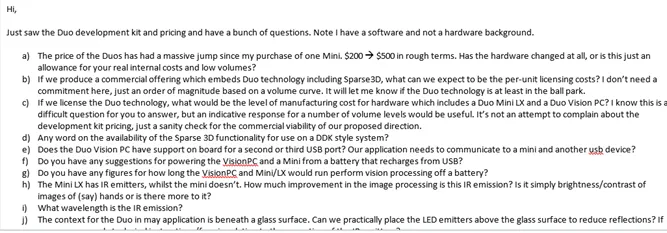September 2014 was dominated by intensive participation in the Curtin Ignition startup accelerator program while continuing hardware experimentation with angled sensor configurations.
Curtin Ignition Program
Six full days (spanning late August through early September) were dedicated to the Curtin Ignition program. This structured accelerator experience covered customer discovery, business model canvas development, pitch refinement, and connections with mentors and fellow entrepreneurs. The program provided frameworks for thinking about Visual Touchscreens beyond pure technology—who would use it, what problem it solved, how to reach customers, and what revenue models made sense.
Feedback requests from the program organizers prompted reflection on the experience. The value wasn’t just in specific lessons but in forced focus on commercial viability alongside technical feasibility. LinkedIn connections made during the program expanded the network of startup community members who understood the challenges of bringing hardware innovation to market.
Angled Sensor Configuration Research
With the accelerator sessions complete, attention returned to a persistent technical challenge: sensor placement relative to the touch surface. Direct placement below transparent surfaces created infrared reflection problems. Could angled positioning solve this?
Experiments began with the latest Leap Motion software, which included access to raw image streams. Angled placement through glass showed promise but proved difficult to maintain at the correct angle. Similar tests with the SoftKinetic depth camera at an angle revealed it performed poorly at close distances. The Duo3D stereo camera showed more promise with angled positioning, though proper evaluation required a stable angled mount.
Rather than commissioning custom acrylic mounts, an off-the-shelf adjustable document holder was purchased from Office Works for quick experimentation. This practical, low-cost approach enabled rapid iteration without waiting for fabrication.
IR Reflection Problem
The infrared reflection issue dominated technical investigation. Research into Leap Motion’s IR mechanisms revealed discussions in their forums about pulse timing and synchronization for IR emitters. An interesting question emerged: if only pulse synchronization mattered rather than physical placement, could emitters be positioned above the glass while cameras remained below? This would separate illumination from sensing, potentially reducing reflections.
Experiments with the transparent document holder surface and Leap Motion image streams clearly showed the three IR beam spots. Testing continued with the Duo3D through the same transparent panel, building understanding of how different sensor technologies behaved with angled, partially reflective configurations.


Touch Panel Procurement Challenges
Ongoing interactions with the njytouch eBay supplier revealed issues with touch panel transparency. Not all capacitive touch panels offered the same optical clarity, and newer models sometimes changed specifications without warning. These procurement challenges highlighted the gap between prototype-suitable and production-ready components. Finding touch panels that offered both good capacitive sensing and excellent transparency while transmitting infrared frequencies required careful vendor management.
Research into alternative technologies led to investigating Zytronic’s capacitive touch products, which marketed better infrared transmission characteristics. However, pricing for these industrial-grade components remained challenging for prototype-scale orders.
Augmented Reality Landscape
Parallel research tracked developments in AR hardware. The Daqri AR helmet and Meta augmented reality glasses represented different approaches to AR interaction. Understanding how these platforms handled hand tracking and interface design informed thinking about where Visual Touchscreens concepts could fit in the emerging AR ecosystem.
Industrial Design Exploration
Contact with Dennis Savic, a graduate industrial designer, opened discussions about form factor and product design considerations. His review of demonstration videos and subsequent conversations brought design thinking perspective to what had primarily been engineering-focused development. Tracking his engagement through Wistia analytics showed the value of being able to monitor which content resonated with different audiences.
Business Development Research
Investigation of innovation support programs continued. The EIP Research program was evaluated but proved targeted at companies with over $1.5M in revenue—well beyond early-stage applicability. The ICWA event on hardware prototype-to-production offered relevant learning about manufacturing considerations that would eventually matter if prototypes progressed to products.
The month demonstrated the challenge of parallel workstreams: participating in business-focused accelerator programs while maintaining technical momentum on hardware challenges. Both domains required sustained attention, and finding balance between business development and R&D execution remained an ongoing navigation challenge.